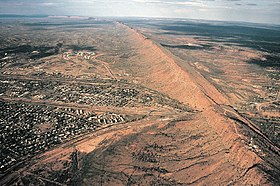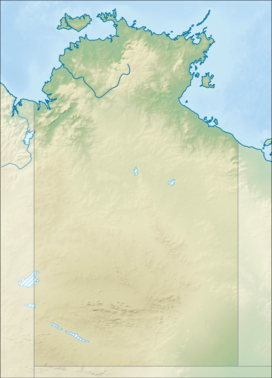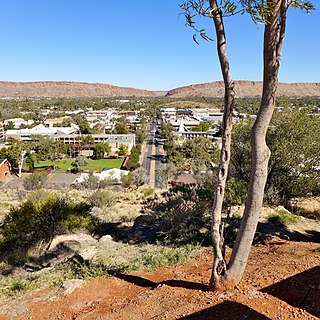
Alice Springs is a town in the Northern Territory, Australia; the third largest settlement after Darwin and Palmerston. The name Alice Springs was given by surveyor William Whitfield Mills after Alice, Lady Todd, wife of the telegraph pioneer Sir Charles Todd. Known colloquially as "The Alice" or simply "Alice", the town is situated roughly in Australia's geographic centre. It is nearly equidistant from Adelaide and Darwin.

Albert Namatjira was an Arrernte painter from the MacDonnell Ranges in Central Australia, widely considered one of the most notable Australian artists. As a pioneer of contemporary Indigenous Australian art, he was arguably one of the most famous Indigenous Australians of his generation. He was the first Aboriginal artist to receive popularity from a wide Australian audience.

Hermannsburg, also known as Ntaria, is an Aboriginal community in Ljirapinta Ward of the MacDonnell Shire in the Northern Territory of Australia, 125 kilometres (78 mi); west southwest of Alice Springs, on the Finke River, in the traditional lands of the Western Arrarnta people.

The Todd River is an ephemeral river in the southern Northern Territory, central Australia. The origins of the Todd River are in the MacDonnell Ranges, where it flows past the Telegraph Station, almost through the centre of Alice Springs (Mparntwe), through Heavitree Gap at the southern end of Alice Springs and continuing on for some distance, passing through the western part of the Simpson Desert, as it becomes a tributary of the Hale River, and eventually flowing into Lake Eyre in South Australia.
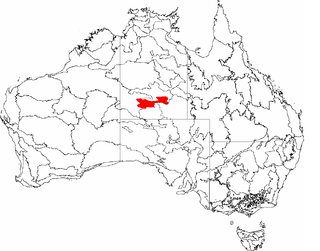
The MacDonnell Ranges, or Tjoritja in Arrernte, is a mountain range located in southern Northern Territory. MacDonnell Ranges is also the name given to an interim Australian bioregion broadly encompassing the mountain range, with an area of 3,929,444 hectares. The range is a 644 km (400 mi) long series of mountains in central Australia, consisting of parallel ridges running to the east and west of Alice Springs. The mountain range contains many spectacular gaps and gorges as well as areas of Aboriginal significance.
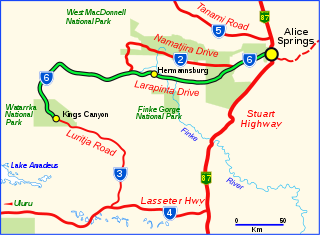
Larapinta Drive is a designated state route in the Northern Territory of Australia.

The Centralian Advocate is an Australian regional online newspaper based at Alice Springs, Northern Territory. The Centralian Advocate is part of News Corp Australia, and serves under the Northern Territory News banner, containing headlines from the newspaper, as well as stories that cover various events and issues primarily outside of Darwin, particularly central Australia. Until 2020, it was published as a standalone bi-weekly print newspaper on Tuesdays and Fridays, claiming a readership of 15,000 people and with an audited circulation of 4401 as of 2018.

Hann Range is a mountain range in the Northern Territory of Australia located in central Australia approximately 120 kilometres (75 mi) north of Alice Springs.
Chanston James "Chansey" Paech is an Australian politician. He is a Labor Party member of the Northern Territory Legislative Assembly since 2016, representing the electorate of Namatjira until 2020 and Electoral division of Gwoja thereafter. He is of Arrente, Arabana and Gurindji descent.

Standley Chasm is a geological formation located west of Alice Springs in the Northern Territory. It lies within the West MacDonnell National Park. The Western Arrernte Aboriginal people are its original owners; it is traditionally known as Angkerle Atwatye, meaning the Gap of Water. Standley Chasm is located in a reserve privately owned by the Iwupataka Land Trust.
Margaret Heffernan, is a Central Arrernte linguist, author, interpreter and translator who is now a well respected elder in her community. Heffernan is responsible for developing the orthography of Arrernte.
Alice Springs town camps, officially called Alice Springs Community Living Areas, are Aboriginal communities within Alice Springs in the Northern Territory of Australia. Their origins vary. Many were originally designed to accommodate people visiting Alice Springs from remote communities but, for many, they have become a permanent and often generational home.
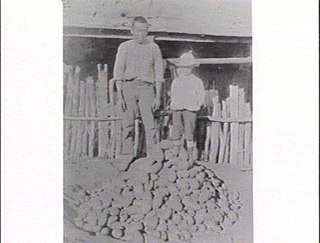
Ah Hong was a Chinese market gardener who spent most of his life in Alice Springs, and was a well regarded figure in an era of considerable prejudice towards Chinese people in Australia.
The Charles River, which is often called Charles Creek is an ephemeral stream in the southern Northern Territory. It is a tributary of the Todd River and, like the Todd River, its naming is associated with Charles Todd; a senior civil servant involved with the Overland Telegraph Line.

Honeymoon Gap is a small gap 1 km south of Larapinta Drive, 14 km west of Alice Springs, on Roe Creek, 8 km south of where it cuts through Simpsons Gap. The Arrernte name for the Gap is Angatyepe and it is associated with Perentie (Goanna) Dreaming. There is an outstation nearby that shares this name nearby.
Friedrich Wilhelm Albrecht was a Lutheran missionary and pastor who was the superintendent at Hermannsburg Mission in Central Australia from 1926 to 1952 where he made a significant contribution.
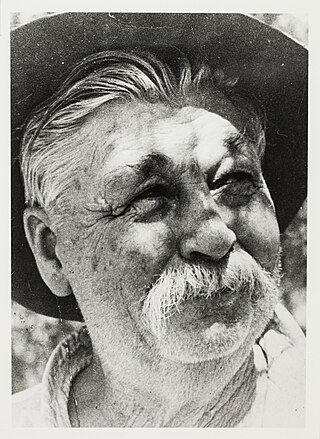
Robert Henry Buck was an Australian pastoralist and bushman who is best remembered as being one of the people to recover the body of Lewis Harold Bell Lasseter.

John Flynn's Grave Historical Reserve, more commonly referred to as Flynn's Grave is the grave site of John Flynn who was an Australian Presbyterian minister who founded the Australian Inland Mission (AIM) and founding the Royal Flying Doctor Service. The grave, which is now a historical reserve, is located at the base of Mount Gillen on Larapinta Drive in the Alice Springs suburb of Flynn.
Little Flower Mission operated from 1938 to 1942 and it was a mission to Eastern Arrernte people who were living in and around the township of Alice Springs. The mission was established by Catholic missionaries, part of the Missionaries of the Sacred Heart order.
Therese Ryder is an Eastern Arrernte artist from Ltyentye Apurte Community, 82 km south east of Alice Springs. Ryder, part of the Iltja Ntjarra Many Hands Art Centre, is primarily a landscape artist and paints her traditional lands in the Central Desert. Ryder is also a linguist who significantly contributed to the Central and Eastern Arrernte Dictionary (1994) and also wrote a book, Ayeye thipe-akerte: Arrernte stories about birds (2017).
